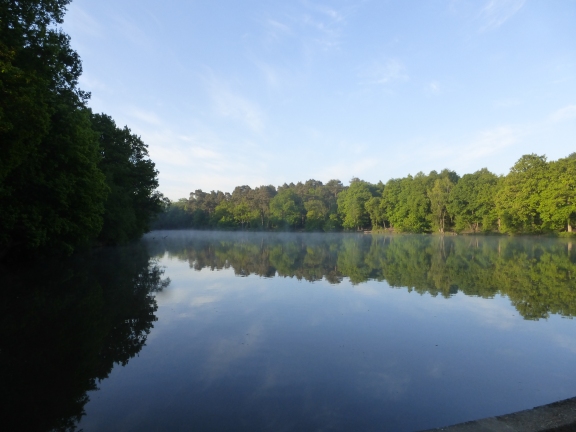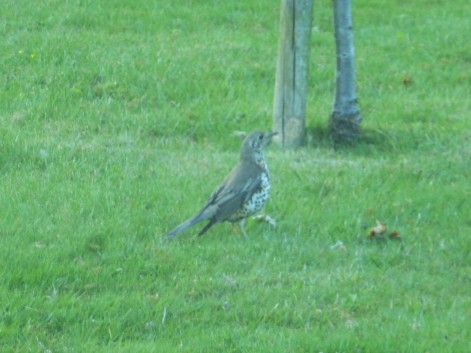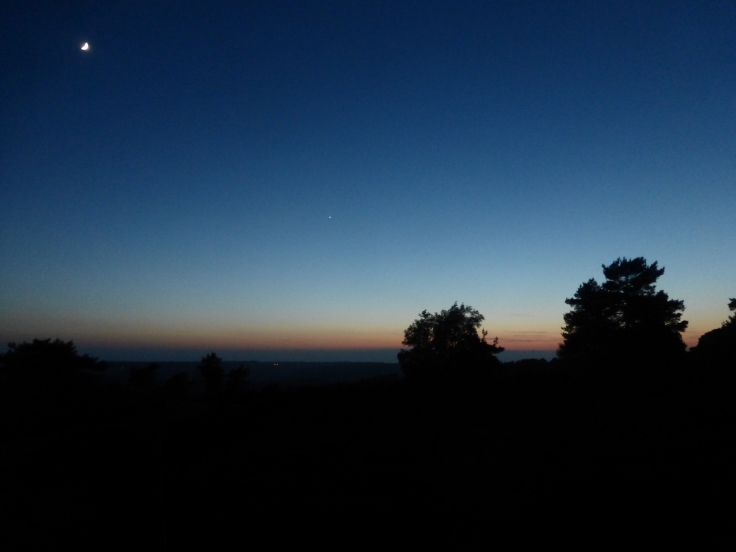Why is the number 100 always such a big deal? Seriously, 100th anniversaries of historical events are always special and made a fuss of, why isn’t the same treatment given to the year before or the year after? And when you’re a child it’s always something to boast about to your mates when you can count to 100. The number 99 is only 1 less than 100, yet it’s nowhere near as satisfying to have 99 of something than it is to have 100. It’s a special number in everything, even in the world of birding. To see 100 different bird species in one day (in the UK) is an achievement my friend John and I have been trying to attain for some years now. It’s harder than it sounds, as the birds don’t often play ball, but surely we could manage it this time, in May, in good weather, right?
Well, we were about to find out if this really was the ‘Big One’, or not, as we set off at six o’clock on a Saturday morning for our first location; with Robins and Blackbirds singing us on our way and predictably being the first birds on the list. Knowing from experience that Grey Wagtails can be difficult to catch up with on a big day our first port of call was Buchan park on the outskirts of Crawley, where I knew a pair was breeding by the lake. Standing by the mirror-flat lake as curls of early morning steam artistically rose from the surface, it was mere seconds before I had seen a male Mandarin duck alongside a Grey Wagtail perched on a partially submerged branch. Tick and tick, then we were off, no time for dallying as we headed for the Knepp Estate.

We had visited the Knepp Estate only last week, so we knew what birds to expect, even if it looked like some of them may be obscured by a thick mist that still shrouded the low-lying fields. A Whitethroat was singing by the road and as we started down the lane a Cuckoo could be heard calling through the mist – you could say it was like being in Cloud-Cuckoo Land, if you wanted to make a bad joke that is. Another highlight was a singing Turtle Dove that we managed to track down across a field, from where it could be seen perched in a tree soaking up the morning sun. We also added Garden Warbler, Bullfinch, Lesser Whitethroat and Green Woodpecker to the list amongst other commoner species before we returned to the car and set off southwards. Our list was up to 40 species by this point, not bad for half-past eight.
We then spent some time at RSPB Pulborough Brooks, which added a lot of new species to the day list. It was good to see some Greenfinches almost straight off the bat, as these have been a bogey bird on past attempts – not being as common nowadays as they used to be. We saw a good selection of duck species here too; including Gadwall, Teal, Shoveler, Shelduck, Mallard and a fantastic bonus bird in the shape of a male Garganey! This bird had been present a few days already and fortunately someone pointed it out to us as it dabbled on one of the pools alongside some Teal. It was also cool to have a Cuckoo calling from a tree directly over our heads. We still hadn’t seen Treecreeper or Nuthatch so we were scanning almost every branch on the way round, but it wasn’t until we’d nearly completed the circuit that a Treecreeper almost magically appeared on an oak tree – the only one of the day.
We then dashed down to the Downs with a healthy 67 species safely on the list, starting to feel confident we made a pit-stop where we successfully saw a Peregrine Falcon before heading up the hills to have a search for some farmland species. The Burgh is an area on the South Downs which is well-managed and great for finches, buntings and raptors in winter especially, so we were a little disappointed to see very few of any of these in the time we were there. It wasn’t fruitless though; we did see both Red-legged and Grey Partridges – the latter bursting from the side of the path like rockets – and we also saw our only Red Kites of the day, as well as a single (!) singing Yellowhammer.
Despite feeling that the Burgh could have been more productive, we had plenty of time to spare and with all of the Pagham Harbour area to go we were still in high morale. We made a whistle-stop tour of Ivy Lake, near Chichester, which only produced one species we didn’t see elsewhere – Pochard, a duck that is tricky to see at this time of year but the lake is well known for them. Then on to the North Wall of Pagham Harbour, where a brisk and surprisingly chilly wind was blowing from the south.
The tide was just right, as the mudflats were still exposed and the sea was rapidly coming in, although the lack of waders kind of nullified our perfect timing. It was nice to see a Whimbrel all the same and some fly-over Mediterranean Gulls looked stunning as the sunshine lit up their porcelain-white wings. Sedge Warblers sang in the reedbed and Little Grebes wrestled on the breech pool, but best of all were three male Wigeon – a most unusual sight this late into the year. With little else to see here, we jumped back in the bird-mobile and drove all the way around to the other side of the harbour.
The brand-spanking new hide was open by the visitor centre, overlooking the Ferry pool, it was most spacious and comfortable and a far-cry from the small, dark, damp and window-less hut that used to sit there. As we sat in luxury we added Avocets to the day list and counted 117 Black-tailed Godwits preening, feeding or sleeping on the pool. A quick look in at the reedbed by ferry channel produced a nice Reed Warbler for us, then it was onward to Church Norton.
This area was still poor on the wader front, but nonetheless we got some great species with Little and Sandwich Terns, Bar-tailed Godwit, Turnstone and a lone Ringed Plover spotted about 10 miles away on an island through the heat haze. It was at this point that I realised how close we were to our goal; with a count of our list totaling 91 species! Only nine birds to go and we would finally reach the holy grail of 100 species in a day! Could we do it? It was late in the afternoon, but it would still be light for another six hours, so we were going to give it our best shot.
A dismal time was had seawatching at Selsey, but at the very least we added a Gannet to the list; we thought it was now time for a change of scene so we headed back inland (not before John had spotted some House Martins over a house by the roadside, a species we were increasingly worried about), over the Downs and through country lanes to a small, charming heathland. It felt like the birds were giving themselves up as we managed to add Hobby, Dartford Warbler, Coal Tit and Siskin to the list within a relatively short fram of time. The Hobby was perhaps the star bird of the day, displaying incredible aerial skill around us as it swooped and dove and switch-backed and sliced through the air on knife-like wings, a truly beautiful bird of prey and an awesome sight in the late afternoon sun.
We were now on 97 species and were in a conundrum as to where to go next as the heath had been our last planned site for the day. With some chin scratching we eventually decided to head back in the direction of home to make a stop at Warnham LNR on the outskirts of Horsham. The reserve was technically closed when we arrived, but we were feverish with excitement by this point and a closed gate wasn’t going to stop us. Fortunately a footpath allows access round the back and we were rewarded for our persistence with an awful view of a Nuthatch – 98.
On our way back out I had a very brief glimpse of what I was 99% sure was a Mistle Thrush, another common bird that had so far eluded us. John had heard the call earlier but we had both been unsure about it, so it was frustrating that the bird didn’t reappear for John to see – it was just enough to count by the rules so it was on the list – so we were now on 99 and one to go and the sun dropping lower and lower. Our last option was Ashdown Forest, a good hours drive away and we still hadn’t eaten anything since lunch apart from a box of Cornettos.
Having picked up our friend Jeanne on the way, we were going through East Grinstead when she spotted a Mistle Thrush out of the window that John and I missed. The car was quickly turned about in someones drive and we shot back to find with some relief a very obliging Mistle Thrush hopping about on a small green – a much more satisfying view and that weak tick was now a firm one.

It was the definition of dusk when we arrived at the Sussex Wildlife Trust reserve of Old Lodge on Ashdown, yet in spite of the blueish half-light I was able to spot and, with quite some excitement, yell out that our 100th species of the day – a fabulous male Stonechat – was perched on a gorse bush just to the left of the path! Fifteen and a half hours of non-stop birding entirely within the borders of Sussex on a fine May day had eventually produced 100 bird species – a milestone we were quite proud of, as it hadn’t been easy.
But wait! It doesn’t end there (oh no, you’re thinking); we knew we could add a few extra to this amazing tally, so we went for a wander in the dark around the midge-infested heath for another half-hour. The 101st species were the Redstarts calling loudly from the black trees, the 102nd species was a distantly calling Tawny Owl making some quite odd vocalisations, the 103rd species was a superb Woodcock that we saw twice roding over the conifers making squeaking noises and silhouetted against the yellow sky. The 104th species – and the very last of the day – were two Nightjars churring away as the crescent moon shone and Sirius, the dog star, shone boldly through the darkening blue of the empty sky.

One of the Nightjars, a male, swooped low over the heather and came very close to where we were stood, sallying back and forth on long wings that flicked through the air like a butterfly’s. It was a magical moment and a brilliant view of one of my very favourite birds, probably the perfect way to end a long, but successful days birding.


May 24, 2018 at 9:06 pm
Love the pic of the Hobby – a favourite of mine too!
LikeLike
May 25, 2018 at 9:16 am
Thanks, it’s a brilliant bird and this one was showing really well.
LikeLiked by 1 person